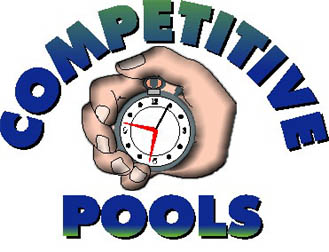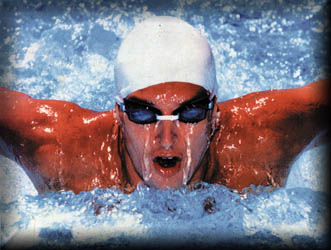
Team Accommodations | Sport Source Directory | Canadian Sport Tournaments | CDN Sport Associations
A FITNESS, RECREATIONAL FACILITY AND PARKS & RECRATION WEB MAGAZINE

You are about to read one of many articles in Cornerstones Web Magazine's Editorial Library.
With-in this sites 200+ pages is an In-Depth On-Line Buyers Guide,
where you can review product information on many
of the major companies with-in the trade, all with just the click of a button.
Thank You for visiting Cornerstones, scroll down to read the article you requested.

by Roger Bacci
So what makes a pool fast?
The question is easy, the answer is more complex and requires examination of all the individual factors involved.
In aquatics like other sports, the difference between winning and losing isn't measured in meters centimeters or millimeters. It's measured in 0.001's of a second. That hairs breadth of difference determines local, national and international records. This pursuit for excellence is challenged by thousands of registered swimmers. They compete through swim meets sanctioned by Swimming/Natation Canada. While all international competitions are governed by Federation International De Natation Amateur (F.I.N.A.).
Temperature
Water temperature has a direct bearing on an individual's performance as a competitive swimmer. A pool that is cold is not only shocking from initial immersion, but yields disappointing times as compared to existing records. Conversely a hot pool does not remove the excess heat (sweat) a swimmer generates and therefore they expend more energy exponentially. This results in slower recorded times. Standard requirement set by F.I.N.A. is 26 degrees Centigrade plus/minus 1 degree. The temperature of the surrounding natatorium is another important factor and should be maintained within 1-2 degrees centigrade above the water temperature
There are basically 4 types of energy (heat) loss in a swimming pool. Environment radiation, evaporation, convection and conduction. On an outdoor installation it is next to impossible to control heat loss/gain. The wind factor can be reduced by protective fencing, hedges, buildings, or landscaping. Indoor pools are governed by humidity, velocity of air, pool surface area and the difference between water and air temperatures. Since 90-95% of heat loss occurs directly at the surface. Even the R value of insulation on indoor pools can reduce condensation and energy (heat) loss.
Pool Sanitation
In order to protect the swimmers' health from cross infection, F.I.N.A. has established recommended bacteriological and chemical criteria for swimming pool water. It is not enough to be sanitary however, as pool water must also meet aesthetic requirements. The unseen friend or foe of competitive swimming is the chemical balance of the waters. The major areas of concern are pH, total alkalinity, free/combined chlorine, calcium hardness and total dissolved solids.
The measurement of pH is a logarithmic scale from 0-14 with 7 as neutral. The comfort zone of swimmers is a pH between 7.4-7.6, since this is the natural pH of our bodies. In competitive swimming an athlete can excrete a substantial amount of sweat and perspiration, which is acidic, causing the pH to lower. Chloramine formation appears quicker at a lower pH, therefore it is important to have a feed system that can keep up with this demand.
The balance of pH is greatly affected by the level of total alkalinity. If the level of alkalinity is too low the pH value can swing dramatically during a meet. On the other hand if the level is too high, the pool water will have a tendency to cause the pH to drift upwards and cause the swimmer discomfort. Ideal range for total alkalinity is between 80-120 part per million.
Everyone is aware of the benefits of chlorine to restrict cross infection between competitors. However, when ammonia/nitrogen, which is found in swimmers sweat and perspiration, is introduced to chlorinated water it produces offensive, chloramine products. These chloramines cause the "red eye" and strong odors that competitors and spectators complain about. The pool water should be breakpointed prior to any meet to remove any excessive contaminants. The free available chlorine should be 1.0-1.5 p.p.m. as determined by D.P.D. test methods with a 0.0 parts per million p.p.m. of combined chlorine.
Calcium hardness levels may not impede a swimmers performance, but competitors find greater comfort in water with a level between 200-275 ppm Total dissolved solids by itself will not cause a pool to be slow, but high levels will cause turbidity, resulting in water clarity problems. This increased level will present athletes with a difficulty in judging the distance of their targets. The level for T.D.S. should be kept well below 2500 p.p.m.
Recirculation System
The design of the recirculation system is crucial in a competitive pool. Water must be skimmed continuously, since dirt bacteria and swimmer wastes collects on the surface. The system must also address water displaced by swimmers (static surge) and waves (kinetic surge) during competition. The water level must be maintained precisely, to ensure consistent times. The best design is a gutter system for effective skimming and surge control. Operating at rim flow, gutters will provide a constant distance between starting platforms and the water at quiescence. Properly engineered gutters are designed to quell waves rebounding from the wall, which slow the times of competitors in outside lanes.
The water returning to the pool must not have any appreciable current or cause turbulence that may impair/aid a competitor. Experts agree that ideally, water should be returned through the bottom of the pool as in a up flow system. This will displace the water evenly without prejudicing any one competitor. Newest innovations in up flow systems, provide for pre-engineered stainless steel channels, contained within the pool shell. This design returns water through openings placed the full length of the racing lane for even distribution.
Lighting
Lighting is important to competition to judge distances and to evaluate the position of other competitors. Lighting can be provided by inpool lights ceiling fixtures or natural sunlight. The minimum illumination for indoor pools is 215 lux and outdoor pools should be at least 110 lux (F.I.N.A). All inpool lights should be restricted to the side walls during competition.
Moveable Bulkheads
In to-days pool design, bulkheads, which can be moved, are necessary to accommodate the variety of competitive requirements. A bulkhead must be uniformly rigid as swimmers utilize this wall to propel themselves on the return leg of the race. If the bulkhead flexes, it will perform lazily, as evidenced in the recorded times. Non-corrosive stainless steel bulkheads are precision-engineered to span the pool within1/4 of an inch. These bulkheads are delivered to site in one piece.
Lane Markers
Racing lane lines represent a great technological advance in competition swimming pool equipment. The new designs are superior in controlling water turbulence, with wave killing action. Coaches and pool designers agree that turbulence can further be reduced by installing a buffer lane along the length of the course. This design requires the wave to pass through the lane line twice, before it can interfere with a swimmer
Deck Equipment
Properly designed starting blocks/platforms with a non slip surface, provides a giant advantage for competitions. The platform should be firm and give no springing effect. False start lines, backstroke flags and stanchion posts, are not only functional equipment, they provide a competitive image to swimmers.
Timers
Since the whole dedication is towards time, a system that responds quickly and accurately is a vital component of any competitive swimming facility. Automatic equipment, complete with touch pads, can realize the difference between a new record or a very competitive swim by any athlete. Because just one hundredth of a second can mean the difference between winning and losing, the start is very crucial. If a start pistol is used, swimmers in the far lane can be at a disadvantaged by almost a tenth of a second. But if an electronic start system with speakers mounted under each starting block is employed, the start is even.

Goggles
Goggles protect swimmers eyes in chlorinated pool water. This allows for clearer vision during competitive swim meets. Modern goggles feature materials that are made of hypoallergenic silicone. Fitted with strong lightweight and fog resistant carbonate lenses.
Bathing Suits, Caps/Shaving
Competitive swimmers have found quicker times wearing "Second Skin" type bathing suits made from lycra. Swimmers traditionally wear a swim cap during competitions, to produce less drag. Today's lycra is popular because its cooler than conventional rubber types. There also exists the "New" trend of shaving the entire head and even all body hair.
Finishing First
Two major factors that should never be overlooked are the coach and the competition. A successful swim coach will earn the best results from his athletes and they in-turn will respond to strong competition.
Roger Bacci C.P.I., C.P.O. - Natare Canada Ltd. is Vice President of Sales and Technical Expertise. He has over 20 years of experience in the commercial aquatics field. Mr Bacci worked in all areas of the aquatic recreation industry. He has consulted and evaluated all aspects of new and existing facilites including nechanical, operational, health and safety, site layout, budgeting and project management.